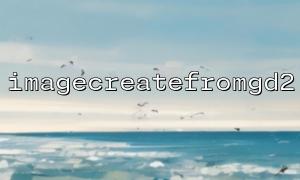When processing images in PHP, imagecreatefromgd2() is a very practical function to create image resources from GD2 files. However, this function throws a warning instead of an exception when encountering an invalid file, a path error, or a file in a non-GD2 format, and is difficult to catch directly through try-catch .
To handle such errors safer and more elegantly, we can encapsulate them through a custom error control mechanism so that they can also be caught by try-catch when an error occurs. This is especially important for the production environment, which can prevent users from seeing unnecessary warning messages and ensure stable operation of the program.
imagecreatefromgd2() usually throws the following warning when processing invalid files:
Warning: imagecreatefromgd2(): gd2: format is not supported in /path/to/script.php on line xx
If left untreated, this warning message will not only expose path information, but may also lead to a decline in user experience or cause abnormal interruptions in automated scripts. Therefore, it is recommended to use set_error_handler() and try-catch to block warnings and handle exceptions uniformly.
Here is an example of a function that encapsulates imagecreatefromgd2() , combining error control and exception handling:
function safeImageCreateFromGD2($filename) {
// Temporarily save error message
$lastError = null;
// Custom error handling functions
set_error_handler(function($errno, $errstr) use (&$lastError) {
$lastError = $errstr;
});
try {
$image = imagecreatefromgd2($filename);
restore_error_handler();
if (!$image) {
throw new Exception("Unable to create image resources,Probably not valid GD2 document。");
}
return $image;
} catch (Exception $e) {
restore_error_handler();
throw new Exception("Failed to process images:{$lastError}", 0, $e);
}
}
You can use it safely like this:
try {
$image = safeImageCreateFromGD2('https://m66.net/uploads/test.gd2');
// Continue to process images when successful
header('Content-Type: image/png');
imagepng($image);
imagedestroy($image);
} catch (Exception $e) {
// Catch and handle errors
error_log($e->getMessage());
echo "Image loading failed,请检查document格式或路径是否正确。";
}
This encapsulation method is also applicable to other imagecreatefrom* series functions, such as:
imagecreatefrommpng()
You can abstract the above wrapping logic into a general image loading function to achieve a wider range of fault tolerance.
In scenarios such as image processing that require high stability, encapsulating imagecreatefromgd2() and combining try-catch is an important means to improve security. Through a custom error handler, we can capture error information that is originally difficult to control and translate it into manageable exceptions. This not only improves code robustness, but also improves the end user experience.
You can integrate the above encapsulation logic into your project framework as a basic tool function to improve overall code quality and error response capabilities.















